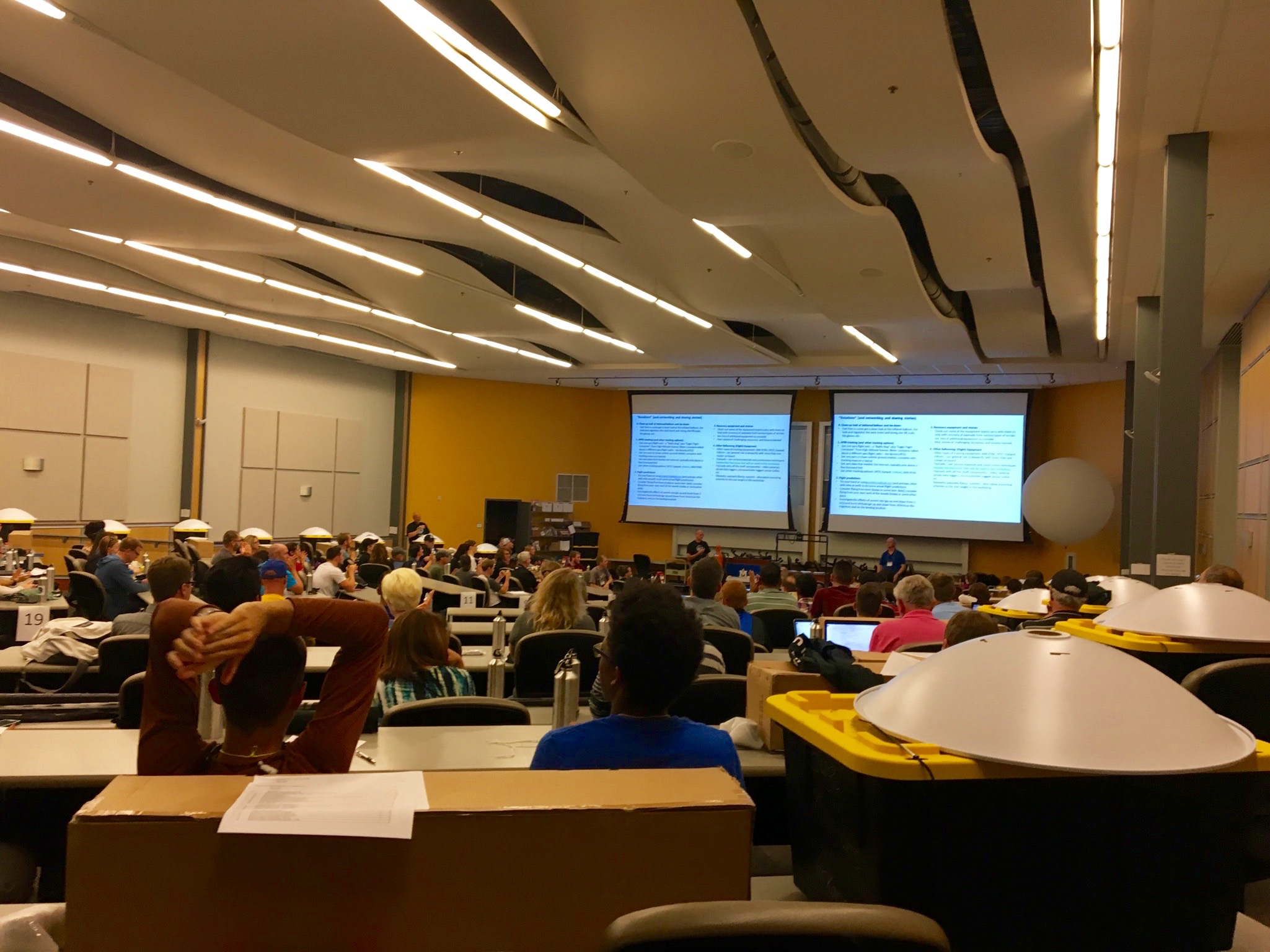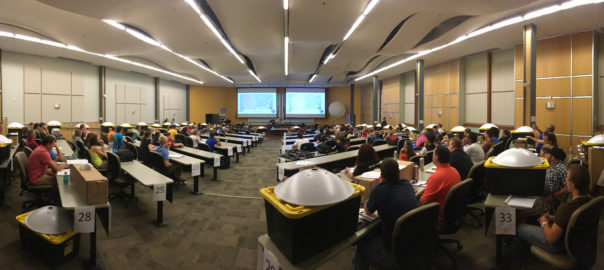Last week, Michael and I attended the NASA Eclipse Ballooning workshop at Montana State University in Bozeman, Montana.
It was an intensive five days that included building a tracking system, a streaming video payload, a still camera system for transmission of images during flight, and a cut-down system.
This massive effort was spearheaded by Angela Des Jardins and NASA Montana Space Grant. As mentioned on the 2017 Eclipse Ballooning Event Facebook page, this workshop culminated from the “groundwork of 55 teams from 30 states, 15,000 preparation hours, and 40,000 parts.”

At our station, in the back of the room, we received a parts list, a surveyor’s tripod, a receiving dish, and a big tub o’ stuff.

We also got some swag: T-shirts, water bottles, and stickers with the Eclipse Ballooning Project logo.

We had lots of refreshments available, including this type of gum.

During the morning of the first day, there was an optional introduction to ballooning session. We were a little surprised at the number of teams that were new to ballooning. Learning how to use the new equipment is daunting enough, but learning how to do ballooning in general over the next year will involve a steep learning curve.
During the day, we heard that Kiss was going to be performing that night at the MSU Brick Breeden Field House across the street from the building where we were having our workshop. With a stop by the ticket office, we were able to get a couple of the few remaining seats.

The show was a full-fledged arena spectacle with pyrotechnics, lasers, flying on wires, and rock n’ roll, not too bad for guys in their 60s.



The second day of the workshop included a majority of the building of the tracking system and payloads, but started out with a demonstration of the equipment.


We then settled in for the build and checked off the inventory before starting each section.


We are using Raspberry Pi devices and this is an example of a case for one of them.


This is the completed still camera payload. The camera is in the green 3D printed case.

The video payload looks a lot like the still camera one. Our 3D printed case for this Raspberry Pi camera is white.

This is the back side of our Iridium modem payload. It uses Iridium satellites and will provide the tracker with GPS coordinates so it can point in the proper direction.

We made some boxes for the payloads by removing some foam and folding and gluing them together.

This is what the final result should look like.

We tested our servos while we were still inside and they worked well. See the following video:
We were able to get an image with the still camera while testing outside.

We were also able to get the video stream to work while testing outside, but were unable to complete the test of the tracking equipment because one of the wires got pinched and needed to be repaired.
The following day, after Michael temporarily fixed the wires to the servos, we were able to get the tracking to function properly. The Iridium payload is in the far distance just to the left of the tree in the middle of screen on following video:
Right after this, our new Dell laptop was infected with some ransom-ware virus that locked it up and disabled the MacAfee antivirus program. The “wizards” (student helpers) were able to remove the malware and restore the laptop without removing all of our updated settings. The experience was scary enough to make me want to have a backup laptop loaded with all of the software we need for the eclipse event, because if something major were to go wrong with the laptop on the day of the eclipse, we would be in big trouble.
For our final day of testing, all of the teams were outside.


During this time, we tested the tracking again and were also able to get the cut-down mechanism to work. We sent an email with the cut-down code to the Iridium network and they sent it to the Iridium modem through a satellite and the modem told the motor to turn on which would cut the line. Note that we do not have the blade attached to the motor yet.
There is no doubt that attending this workshop and gaining these new capabilities (tracking, streaming video, and electronic cut-down) will take our ballooning program to the next level. We also feel we have a lot of testing of the system to do during this next year so we can be successful for the eclipse.
We would like to thank the NASA Science Mission Directorate for the funding of the equipment, NASA Nebraska Space Grant for supporting our attending the workshop, Angela Des Jardins and Montana State University for hosting, and Chris Koehler and Randy Larimer for facilitating. Last but not least, we would like to thank my parents, John and Bev Stahl, for caring for the boys and the dog while we were gone.
___________________________________
Bonus Pictures from our drive home:
On the way home, we decided to drive through the northern part of Yellowstone National Park. We had visited the park before, but only saw the attractions in the southern part.
The Roosevelt Arch at the northern entrance to Yellowstone.

Mammoth Hot Springs area in Yellowstone.



Tower Fall area.


I love this section of hexagonal columns. It reminds me of the Devil’s Tower formations.

We saw several mule deer in the park, but we ended up seeing thousands of bison.


